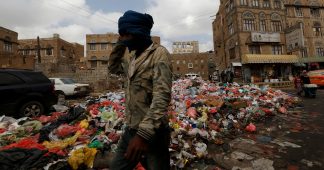28 January 2020
In a matter of weeks, the outbreak of coronavirus centered in Wuhan, China has shut down a major global metropolis of 11 million people, larger than New York City.
The outbreak has exposed the enormous vulnerability of contemporary society to new strains of infectious disease, dangers for which no capitalist government has adequately prepared.
Local medical infrastructure at the epicenter of the crisis is being pushed to the brink of collapse, while a total of 15 cities in the Chinese province of Hubei, including Wuhan, have been placed under partial or total lockdown, imposing a quarantine on the vast majority of the region’s 58.5 million people.
Videos and photographs posted on social media reveal packed hospital waiting rooms as panicked residents exhibiting fevers and other flu-like symptoms seek medical treatment. Doctors, nurses and other medical staff have been forced to work around the clock in order to treat the infected and diagnose suspected cases, even as medical supplies run dangerously low.
Outside the hospitals, people have rushed to stockpile essential goods, fuel, food and water, increasing the prices of basic necessities. The chaos also has caused delays for those seeking other routine but necessary medical treatments. Public transportation within Wuhan has been suspended, forcing hospital workers to walk or use private cars, as hired vehicles would not take them for fear of being infected.
The 4,494 known cases in China and 106 deaths have brought all aspects of social life for hundreds of millions of people to a standstill.
There are currently 65 cases outside China in 14 countries—Australia, Cambodia, Canada, France, Japan, Malaysia, Nepal, Singapore, South Korea, Sri Lanka, Taiwan, Thailand, the United States and Vietnam. Health officials in China and internationally have warned that the spread of the contagion is accelerating, with Guan Yi, one of China’s leading virologists and a veteran of the 2003 SARS epidemic, stating that “the Wuhan outbreak is at least 10 times larger than that of SARS.”
At the same time, the economic disruptions, illnesses and deaths are being compounded by the poverty, social inequality and degraded health care infrastructure in the infected areas. It must be noted that while the situation in China is dire, the so-called first-world countries are no more prepared to deal with an outbreak on the scale currently occurring in Wuhan. Every year, 30,000 people in the United States alone die from influenza, a much less contagious disease than the Wuhan coronavirus.
One of the main dangers of the novel coronavirus is that an infected person can pass it on even if they are not exhibiting symptoms, a period that averages 3-7 days and can last up to 14 days. Researchers at Hong Kong University, led by Dean of Medicine Gabriel Leung, estimate that there are actually 25,630 people showing early symptoms of the pneumonia-like illness in Wuhan alone, a number that will nearly double to almost 44,000 within six or seven days.
In the United States, five cases have been confirmed and a further 110 patients remain under observation. These numbers “will only increase,” according to Nancy Messonnier, director of the National Center for Immunization and Respiratory Diseases, an agency of the federal Centers for Disease Control (CDC).
The potential spread of the virus mere weeks after it was identified speaks both to the virulent nature of the virus and the highly integrated nature of modern economic and social life, particularly involving China and the rest of the world. The Wuhan coronavirus is spreading at least four times as fast as SARS and infecting at least five times as many people, in large part a result of the ease at which people can travel to and from the country.
The growth of air travel since the turn of the millennium, however, has not increased the level of international preparation to combat the spread of infectious diseases. As the flow of people across international borders has hit record highs, which necessitates international coordination to stop the spread of disease, organizations such as the CDC have had their funding slashed from $10.8 billion in 2010 to a proposed $6.6 billion in 2020. The World Health Organization, which receives 80 percent of its funds from voluntary donations, had a budget of only $5.1 billion in 2016-2017.
At the same time, the United States Congress has just passed a defense authorization bill of $738 billion. The annual Chinese defense budget is estimated to be as high as $250 billion. This is to say nothing of the $6 trillion that the United States has spent on the “War on Terror” and the trillions more handed to Wall Street banks in the aftermath of the 2008 crash.
Put another way, while the governments of the world, particularly the United States, have made meticulous plans for large-scale war during the past quarter-century, no such resources or forethought have been devoted to combating the rash of epidemics that have plagued the planet over the same period. Since 1996, there have been 67 epidemics across the world, including the outbreak of mad cow disease from 1996 to 2001, influenza in 2009, Zika in 2015-2016, and the continuing HIV/AIDS epidemic, which has killed at least 30 million people since it first emerged in 1960.
These disasters are at every turn preventable. Medical science has advanced to the point where it is capable of identifying new viruses within weeks and developing vaccines within months. And yet, as then-WHO Director General Dr. Margaret Chan noted in 2014 in relation to the Ebola outbreak, “a profit-driven industry does not invest in products for markets that cannot pay.”
This theme is echoed in every epidemic and natural disaster, from the wildfires this past year in Brazil, California, Africa and Australia to the increasing damage caused by typhoons and hurricanes, to the myriad of catastrophes being caused by climate change. The short-term, mercenary profit schemes that are inherent to capitalism are incapable of allocating the resources necessary to plan ahead and prepare for global risks. Rooted in the nation-state system, every capitalist country presses for its own advantage in the present, while sacrificing the future, cutting across serious and scientifically necessary international collaboration.
These conflicts are only escalating. At a time when rational planning across national borders is critical to combat the global spread of a virulent disease, the United States and China are locked in a growing trade conflict in what has been called a new “cold war.” Even as new pathogens require the scientific resources of every continent to combat, the countries of the world are building metaphorical and literal walls.
The defense of human civilization against the threat of global pandemics, just like climate change and the growing threat of ecological disasters, requires a level of planning and global cooperation of which capitalism is incapable. Society has outgrown the capitalist system and the arbitrary divisions it imposes on the world. The provision of the most existential social needs requires rational planning. That is, it requires socialism.
Bryan Dyne
Published at https://www.wsws.org/en/articles/2020/01/28/pers-j28.html











